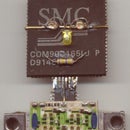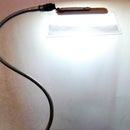Introduction: 4-1/2 Digit Panel Meter
A man with one voltmeter knows his voltages. Perfectly. When, due to the pressures of circumstances, he acquires one more, he doesn't, any longer. Each meter will have its own interpretation of the voltage presented to it, and this can cause confusion when relying upon them to perform critical tasks such as charging Li-Po batteries.
This instructable describes a Four-and-a-half digit voltmeter based on the MAX1498 ic from Maxim. It comes calibrated from the factory and all you need to do is to add the components to supply power to it, and to display the output from it.
With four and a half digits, this meter can display counts upto 19999, plus or minus. The "and half" part of the designation comes from the fact that the first display, used to indicate the sign (+ or -) can, without much effort, be used to display a "1" as well.
Since most multimeters used for servicing are of the three and a half digit variety this little circuit can be used to keep a bunch of them agreeing with each other.
Calibration is free, comes with the chip, built in, so as to speak, and does not depend upon any external components you connect to the chip.
Step 1: Getting the Parts Together
Apart from the MAX1498 chip and five seven segment common cathode displays, there isn't much to acquire. The other stuff needed can easily be pulled off any hard drive board.
Step 2: The Circuit
The picture is the suggested circuit from the datasheet of the MAX1498. It is suggested that we do not get too creative with it.
Maxim made it, so they should know which way to connect it.
Step 3: The Pin Assignment
The figure shows the pinout of the ic. Eight outputs for the seven segments and decimal point. Five outputs for the display cathodes. Five supply connections. Two inputs. A few digital inputs to control the behaviour of the chip. The data sheet will have the full details if you wish to probe further.
Step 4: Planning to Connect It Up
I printed out the pin diagram and drew the external connections in. Peak and hold inputs were held inactive. The internal reference was used. The decimal points were set to be displayed, and the 2V/ 200mV selection would be by an external switch.
Step 5: Wiring Up Five Displays in Parallel
The series of pictures show steps in connecting up all the segments of the five seven segment LED displays in parallel.
Later, I disconnected all except A,B,C & dp of the leftmost display - it needs to be a special type with +, - and 1 if all segments are to be connected.
The five displays were lined up and stuck together with superglue. Then two strips of circuit board with parallel stripes (veroboard) were used, connecting similiar segments together. The cathodes of the displays are not connected at this stage.
Step 6: Making the Board
The circuit board to house the MAX1498 was made by etching with saltwater. The footprint of the ic was etched and the other components were mounted on lands isolated by cutting with a knife.
A 3.3V low dropout regulator liberated from an old hard drive was used to condition the power to the ic. This regulator was protected from overvoltage and reverse polarity by a 9V zener diode.
The pictures document the various stages in making up the board. There is a continuous ground plane under the ic. I later glued a piece of copper foil over the chip and connected that, too, to ground. The AVdd pin gets power through a ferrite bead. Tantalum surface mount capacitors and multilayer ceramic capacitors were used for decoupling the supply to the chip.
The current per segment was set to about 10 mA by using a 47K resistor at the Iled set pin.
The two analogue input pins are not soldered to the board. Two wires connect this to a separate piece of glass epoxy board which carries two 330 ohm resistors and 100n capacitors to ground. In addition, the neg input has been given a "static leak" via a 1Meg resistor. The chip will work from 2.7 V to 5.5V, so I intend to power it from three or four AA cells.
Step 7: The Result
Finally, it works. In the pictures, it is displaying the voltage of a single dry cell and the display holds steady. As you can see, there is a change of just one count in that last digit.
That last digit represents 100 microvolts. It is on its 2V range, so the decimal point is set for reading it in terms of millivolts.
It works so well, and now I can know any voltage in the range 100 millivolts to 2 volts with an accuracy of 0.1%.
That is, I do now, until I build another one and compare readings.













